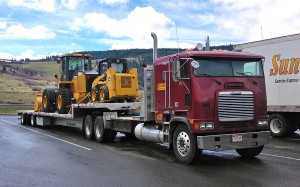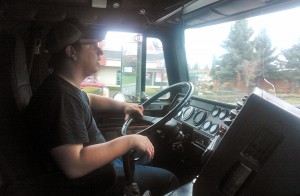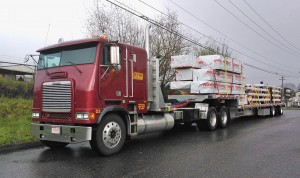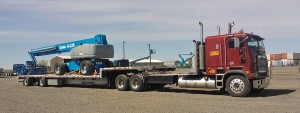 It seems that less people are buying their own truck and becoming an owner-operator these days. With all of the ridiculous regulations, high fuel prices, cheap freight rates, and a slew of other “complications” to deal with, many are choosing the less complicated route of being a company driver – and there’s nothing wrong with that. For some, it’s better to let others worry about fuel, maintenance, taxes and regulatory filings. For me, however, it has long been my goal, since before I even learned to drive a truck or got my license, to someday own my own truck. And, after a few years of driving other people’s rigs, I can proudly say that I am now a truck owner and a bona fide owner-operator!
It seems that less people are buying their own truck and becoming an owner-operator these days. With all of the ridiculous regulations, high fuel prices, cheap freight rates, and a slew of other “complications” to deal with, many are choosing the less complicated route of being a company driver – and there’s nothing wrong with that. For some, it’s better to let others worry about fuel, maintenance, taxes and regulatory filings. For me, however, it has long been my goal, since before I even learned to drive a truck or got my license, to someday own my own truck. And, after a few years of driving other people’s rigs, I can proudly say that I am now a truck owner and a bona fide owner-operator!
Earlier this year I bought my first rig – and it is no ordinary truck. Perusing the classifieds, I looked at all of the obvious options like 379 Peterbilts, W900 Kenworths and Freightliner Classics, but none were getting me very excited. Many had good and bad points, such as engines with known problems or oddball transmissions (the notorious “Lightning” 10-speed seemed to abound). My search quickly became an exercise of indecision – then, one caught my attention.
 Hailing from California, I found a 1997 Freightliner FLB that was being sold due to CARB issues, and the truck was far from ordinary. For starters, it was a cabover – something seen less and less these days. But, it wasn’t simply a cabover – it was a cabover sitting on a 270-inch wheelbase! Coming from Stockton, the truck was an older unit owned by Dan Reeve’s Trucking. No longer emission compliant in its’ home state, the aging cabover was being sold as the company was updating their fleet, so I scooped it up.
Hailing from California, I found a 1997 Freightliner FLB that was being sold due to CARB issues, and the truck was far from ordinary. For starters, it was a cabover – something seen less and less these days. But, it wasn’t simply a cabover – it was a cabover sitting on a 270-inch wheelbase! Coming from Stockton, the truck was an older unit owned by Dan Reeve’s Trucking. No longer emission compliant in its’ home state, the aging cabover was being sold as the company was updating their fleet, so I scooped it up.
A lot of people were a little surprised by my choice, as cabovers can be tricky to live in. Simply put, there’s a lot less living space inside of them, so that can be an issue for some. Talking with friends, they’d go on endlessly about their refrigerators, microwaves, TVs, and other accommodations in their mammoth 48-, 63- and 70-inch sleepers, but my new truck has the equivalent of a 36-inch bunk – that’s also only half the height of a regular bunk. But I love it. I’ve always preferred simplicity. Some would say the sleeper is cramped, but for me, it’s cozy. My truck carries me and my clothes, and that’s about all I carry when out on the road anyway!
 The truck’s wheelbase generated some questions, too (270-inches is on the longer side, even for conventionals). For a cabover, that sort of rail is not very common and, for some, it is obscene (there is about twelve feet between the nose of the trailer and the back of my headache rack). Why so much rail? Well, for one, it looks cool. Simple as that. Some decisions are made on looks more than practicality. But, having spent a lot of my time around heavy-haul and oversize trucking, I also knew the truck had a big advantage over conventionals, and it was the same reason Dan Reeves had built the truck so long: front overhang. For many trucks, getting more than four feet of a load over the front of the trailer can cause clearance issues. Knowing that most of my work would involve open decks of varying sorts, that long wheelbase and stubby cab meant doing long loads without permits, or less permitting. Plus, it looked cool.
The truck’s wheelbase generated some questions, too (270-inches is on the longer side, even for conventionals). For a cabover, that sort of rail is not very common and, for some, it is obscene (there is about twelve feet between the nose of the trailer and the back of my headache rack). Why so much rail? Well, for one, it looks cool. Simple as that. Some decisions are made on looks more than practicality. But, having spent a lot of my time around heavy-haul and oversize trucking, I also knew the truck had a big advantage over conventionals, and it was the same reason Dan Reeves had built the truck so long: front overhang. For many trucks, getting more than four feet of a load over the front of the trailer can cause clearance issues. Knowing that most of my work would involve open decks of varying sorts, that long wheelbase and stubby cab meant doing long loads without permits, or less permitting. Plus, it looked cool.
Mechanically, the truck is outfitted with a 460-hp N14 Cummins, a 13-speed transmission and 3.55 Rockwell QD100 rear gears, which is something else I found unique about this truck. The powertrain exemplifies the transition period between the days of fully-mechanical trucks and the coming age of the electronics. The N14 was the culmination of 40 years of development of the big-bore 855 cubic-inch Cummins engine, going back to the 335s and 250s. The rear ends are much the same, being a culmination of the SQHD and other HD series rears that Rockwell had been producing for decades. Also, the cab of this truck represents nearly the same basic structure that Freightliner has been using since the 1950s, following their original bubblenose offerings, so there is a lot of history there, too. The truck isn’t exactly old school, but it certainly has that classic look, feel and attitude.
 But, as I have quickly learned, owning a truck is not just about driving. Anyone looking to become an owner-operator needs to be ready to kill a few trees in the name of paperwork. Filings with the IRS, DOT, DMV and many other agencies, as well as the paperwork for lease-operators, is part of the long and tedious process of getting everything started. Don’t plan on all of this being immediate or all going to plan, either. Paperwork alone can eat up two weeks of your time before you ever even get under your first load.
But, as I have quickly learned, owning a truck is not just about driving. Anyone looking to become an owner-operator needs to be ready to kill a few trees in the name of paperwork. Filings with the IRS, DOT, DMV and many other agencies, as well as the paperwork for lease-operators, is part of the long and tedious process of getting everything started. Don’t plan on all of this being immediate or all going to plan, either. Paperwork alone can eat up two weeks of your time before you ever even get under your first load.
It certainly isn’t all fun and games at first, but the greater the headache and gamble, often the greater the reward, as well. Win, lose or draw, going rogue (becoming an owner-operator) is something some of us are just born to do. Simply put, I want to be in control of my own destiny as much as possible! My best advice, and right now it is the only advice I can offer since I am just getting started: be sure to pack plenty of Tylenol for the inevitable headaches!
Editor’s Note: Special thanks to Troy’s friend Elizabeth Pilcher for taking and providing the picture of Troy in the driver’s seat of his “new” Freightliner!

1 Comment
Great article. Any chance of getting in touch with Troy, I would like to know how things are going as an O/O with the cabover. David.